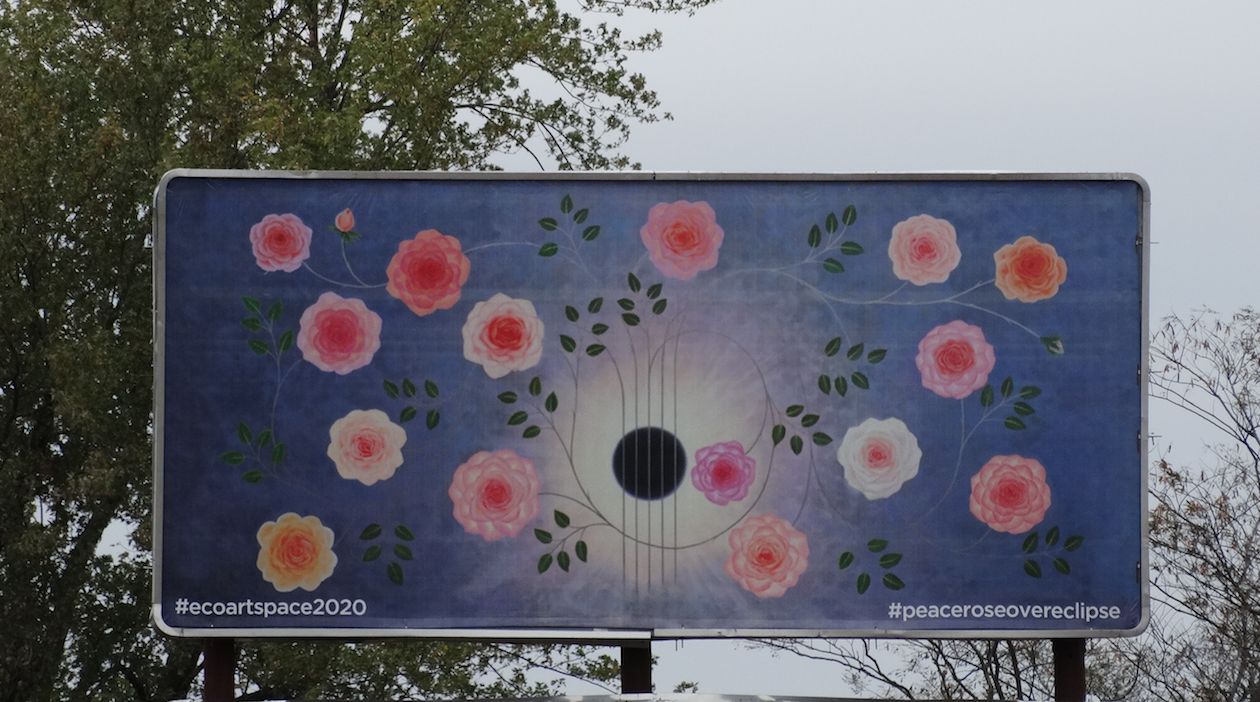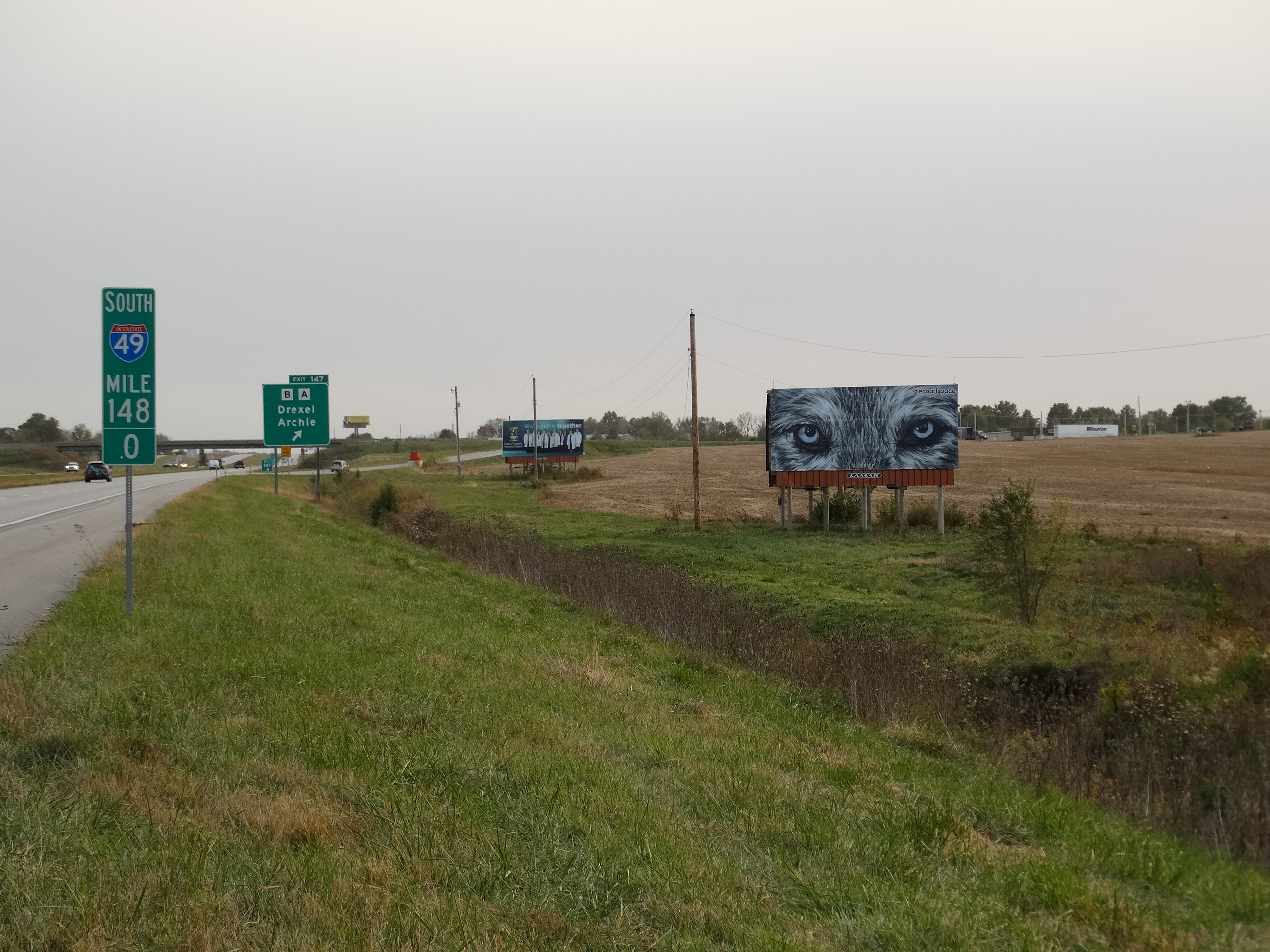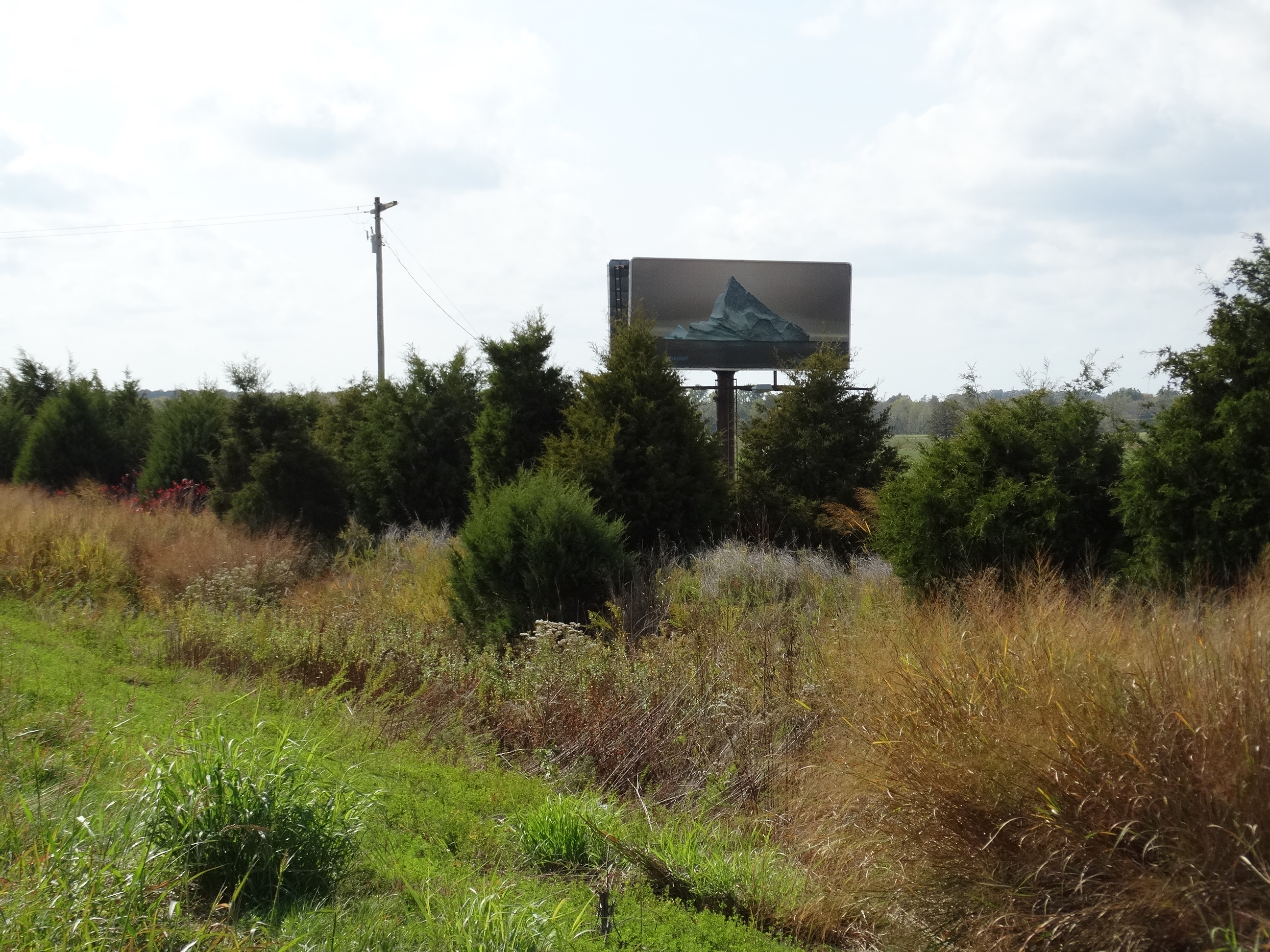
The ecoartspace online + billboard fall 2020 exhibition titled ecoconsciousness which launched back in September with an interactive catalogue, also includes billboards placed along Interstate 49 in Missouri near the state lines of Kansas, Arkansas and Oklahoma. Over 150 artists applied to the juried show, many with the hope to be selected for the billboards. However, of the 80 artists selected by New York art critic Eleanor Heartney, only three works were chosen to be displayed for three months each. On the ground images of the billboards were recently taken, see below, along with the artists statements and information about each billboard location.
You can view the online catalogue here.
We still have a few print catalogues left if you would like to purchase one from our store here.
Excerpt from the econconsciousness catalogue:
The three billboards selected are sited in rural west and southwest Missouri along and near Interstate 49, which runs between Pineville, Missouri (10 miles north of the Arkansas border) up to Interstate 470, the beltway in Kansas City. The cities of Neosho and Monett are located in the Missouri Ozarks and were each included in The 10 Most Conservative Cities in Missouri for 2019. Archie is considered “moderately conservative,” however, the county voted Republican the last five Presidential elections and Republicans held twelve of the thirteen elected positions there as of the 2014 election. Missouri has historically been viewed as a bellwether state, although, they have not voted for a Democratic president since 1996 (Clinton). All three billboards will be up past the elections on November 3, 2020.
Archie, MO

Rebecca Clark
Oh, what did you see, my blue-eyed son?, 2017
graphite and colored pencil on paper
3.5 x 7 inches
Artist Statement: My drawing “Oh, what did you see, my blue-eyed son?” focuses on a pair penetrating pale blue eyes staring out from the half- hidden face of a wolf pup. The title, taken from Bob Dylan’s epic 1962 ballad, “A Hard Rain’s a-Gonna Fall,” implies a familial relationship. Within the context of the drawing, this is a human/ animal relationship and the wolf’s hard gaze is fixed firmly upon the viewer: you, me, us. What devastation did our blue-eyed son witness out there in the world? Will he, will we, survive?
rebeccaclarkart.com
Location: 36°48’01.3”N 94°25’12.8”W
Interstate 49, at milemarker 21.6 southbound near Neosho, MO, Exit 20
Billboard: North facing, 10.5 x 22.75 feet
Elevation: 1,037 feet above sea level
About Archie: Archie is a city in southern Cass County, which is part of the Kansas City metropolitan area. On August 10, 1932 a meteorite fell near Archie that received national attention. A fragment of the meteorite known as “Archie” is on display in the Smithsonian National Museum of Natural History in Washington, D.C.. The population was 1,207 as of 2018. Archie was platted in 1880, and named after Archie Talmadge, the son of a railroad official. The town hosts an annual tractor pull in September.
This area of Missouri was previously inhabited by speakers of the Dhegihan Siouan-language family: The Osage, Quapaw, Omaha, Ponca and Kansa tribes make up this sub-group. Other historical tribes in the area were Shawnee and Lenape (aka Delaware), whose tribes spoke related Algonquian languages. The Lenape had been pushed to the Midwest from their territory along the mid- Atlantic coast by continuous white encroachment. In 1818 the United States granted land to the Lenape in southern Missouri Territory, but they were forced to cede it back in 1825, after Missouri became a state. At that time, they were removed to a reservation in Kansas. Those who remained in this area were close relatives of the Sauk, Fox and Kickapoo tribes. The early camp meetings held by European-American settlers near Archie often attracted as many as 500 Indigenous peoples, in addition to Europeans. (excerpted from Wikipedia by ecoartspace)
Neosho, MO

Diane Best
Iceberg, Scoresbysund, 2016
digital photograph
26 x 34 inches
Artist Statement: This image was captured on a trip to remote northeast Greenland, on a 1920 Danish sailing ship with a group of 12 other photographers. The fjord system we sailed through is the deepest in the world, with many twists, turns, islands and steep cliffs. Icebergs get trapped in there, which make for captive subject matter - and the water can be as still as glass. This iceberg was out in the deeper water, and was one of the first really big ones we encountered. The photo is notable because I think it was the first time the final image came out exactly how I saw it in my head before I went out shooting! I generally come back with good images, but they are usually not what my original intention was....landscape photographers must be adaptable.
dbestart.com
Location: 36°48’01.3”N 94°25’12.8”W
Interstate 49, at milemarker 21.6 southbound near Neosho, MO, Exit 20
Billboard: North facing, 10.5 x 22.75 feet
Elevation: 1,037 feet above sea level
About Neosho: Neosho is the childhood home of painter and muralist Thomas Hart Benton (1989-1975), as well as African American inventor and botanist George Washington Carver. It’s located in the Southwest corner of the Ozarks in Missouri, also known as Tornado Alley due to the cold air from the Rocky Mountains and Canada which collides with warm air from the Gulf of Mexico. It’s population is approximately 12,000 people. Founded in 1839, the name, NE-O-ZHO or NE-U-ZHU, is a Native word of Osage derivation, meaning clear or abundant water, referring to local freshwater springs. The springs attracted varying cultures of Native American inhabitants for thousands of years. White settlers who founded the city in 1833, nicknamed it “City of Springs.” Neosho claims to be the “Gateway to the Ozarks” from the west. (excerpted from Wikipedia by ecoartspace)
Monett, MO

L.C. Armstrong
Peace Rose Over Eclipse, 2020
oil on linen panel
36 x 72 inches
Artist Statement: For the past 20 years, my work has celebrated the natural world. As a child, I spent long summer days, in the Tennessee woods, daydreaming. These early years were influential in building my visual vocabulary. When I was nine, my family drove to California, in two pickup trucks, on Hwy 66. New landscapes now presented themselves; desert sunsets, red rock canyons, the Pacific Ocean. Like the Hudson River School painters, my works seek to highlight the sanctity of nature. In “Peace Rose Over Eclipse,” rose stems magically transform into silver guitar strings. The black disc of the eclipse also can be seen as a guitar sound hole, and rays of light reverberate from it. Music, like art, is a language we can all understand. The “Peace” rose celebrated the end of WWII. It’s sunny, optimistic burst of yellow, blushing to deep coral, signifies new beginnings, and hope for a bright future after the darkness of the eclipse.
lcarmstrong.com
Location: 36°53’40.1”N 93°55’17.6”W
Hwy 37, 1.5 miles south of junction Hwy 60 in Monett, MO
Billboard: North facing, 10.6 x 22.9 feet
Elevation: 1,378 feet above sea level
About Monett: Southwest Missouri is a collection of cities, towns, and communities in the heart of the Ozarks between the metropolitan areas of Joplin and Springfield and the Fayetteville-Springdale-Rogers in Arkansas. Monett was established in 1887 as a trading post and shipping center for the St. Louis-San Francisco Railway, later known as the Frisco. Monett had a thriving fruit business and was nicknamed the “Strawberry Capital of the Midwest.” The Ozark Fruit Growers Association building (built in 1927), which is part of the Downtown Monett Historic District, is on the National Register of Historic Places. In 1894, a lynching and race riot took place in Monett before the violence spread to other southwestern Missouri towns. Monett became a sundown town, banning African Americans from living or staying there after dark, with a sign across the main street saying: "Nigger, don't let the sun go down." Missouri had the second highest number of lynchings outside the Deep South—60 between 1877 and 1950. Monett had a population of 9,124 as of 2019 and twenty churches. (excerpted from Wikipedia by ecoartspace)